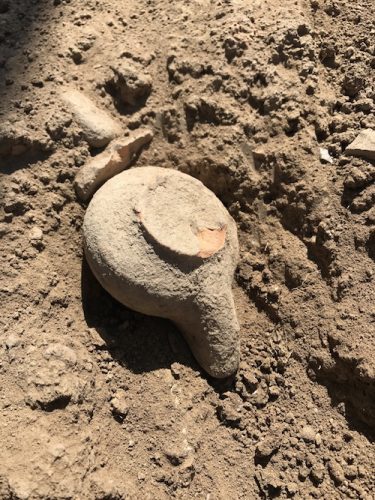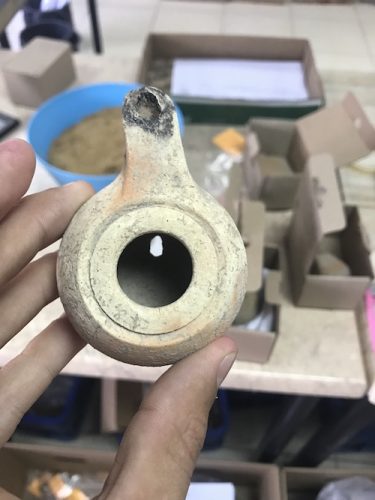Here at Tel Akko, at the end of every day, there is a tradition we call Find of the Day. In this we showcase the most interesting and valuable objects uncovered during that day’s excavation. The position of the ‘victor’, and a free ice cream, is given to the person who’s find receives the largest amount of applause; of course, to avoid bias, each find is listed anonymously.
Today’s find of the day was an intact small oil lamp from the late Persian/early Hellenistic period (4th Century BCE – 1st Century BCE) that was uncovered in the Garea. This oil lamp is a very special find for us here at Tel Akko, because artifacts are rarely found complete. Interestingly, the lamp’s nozzle, from which the wick would stick out, still has the scorch marks from when it was lit in the home of a resident here in ancient Akko. The discovery of this amazing little artifact provides us great insight into the daily lives of the ancient Akko residents. This lamp proves to be a light into moments lost in the annals of history.
Oil lamps such as this were commonly used in antiquity to provide light. They were simply household appliances, much like today’s televisions, light bulbs, refrigerators, and even smartphones for us in the 21st Century. Being ceramic these lamps broke fairly easily, a reason why they are so rarely found fully intact. This specific type of oil lamp was typically produced approximately between 375 BCE and about 250 BCE. We are able to tell their dating “…on the basis of general parallels from Agora and Dor” (Martin, 758, 760). However, at the moment, it is unclear whether this specific style/design was Persian or Greek in origin. This particular lamp was locally produced in Phoenician ware, probably based on Attic styles of a similar nature. The differences between Attic potteries and their Phoenician counterparts are the clays and their appearances; the Phoenician recreations were, for the most part, unslipped on their exterior, while the Attic wares’ exteriors were almost always slipped (Martin, 760).
Attached below are some shots taken when the oil lamp was discovered in Area A (The Garea), and photos from after it had been thoroughly cleaned by the pottery experts.


Sources:
- Rebecca Martin, “East Greek” and Greek Imported Pottery of the First Millenium BCE, chapter 14 in The Smithsonian Institution Excavation at Tell Jemmeh, Israel 1970-1990, edited by D. Ben-Schlomo and G. Van Beek. Smithsonian Contributions to Anthropology 50. Washington DC: Smithsonian Instituion Scholarly Press, 749-75
- Discussions with Prof. Martha Risser of Trinity College, Hartford, Connecticut.

No Comments